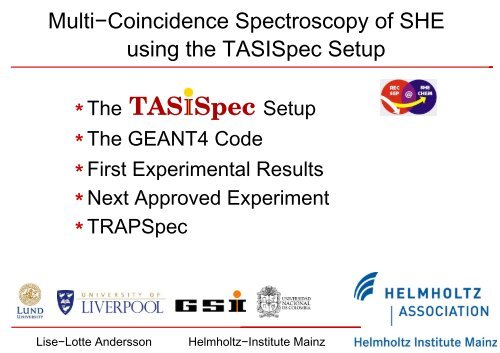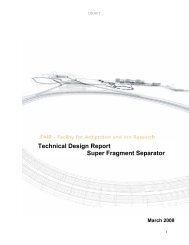Recent TASISpec Results - GSI Webserver WWW-WIN
Recent TASISpec Results - GSI Webserver WWW-WIN
Recent TASISpec Results - GSI Webserver WWW-WIN
Create successful ePaper yourself
Turn your PDF publications into a flip-book with our unique Google optimized e-Paper software.
Multi−Coincidence Spectroscopy of SHE<br />
*<br />
using the <strong>TASISpec</strong> Setup<br />
The TAS ISpec<br />
Setup<br />
* The GEANT4 Code<br />
First Experimental <strong>Results</strong><br />
*<br />
*<br />
*<br />
Next Approved Experiment<br />
TRAPSpec<br />
Lise−Lotte Andersson Helmholtz−Institute Mainz
The TAS ISpec<br />
Detector Set−up<br />
TASCA in Small Image Mode Spectroscopy<br />
1 DSSSD (32+32 strips)<br />
4 DSSSD (4*[16+16] strips)<br />
4 Ge Clover (4*4 crystals)<br />
1 Ge Cluster (7 crystals)<br />
ER<br />
TASCA<br />
L−L Andersson et al., NIM A 622, 164 (2010)
Clover<br />
The TAS ISpec<br />
Detector Set−up<br />
Clover<br />
Clover<br />
Details of the construction<br />
Cluster<br />
Clover
The Full <strong>TASISpec</strong> Setup in Geant4<br />
Programmed (in great detail) by: L. G. Sarmiento
Simulated Absolute Efficiency (%)<br />
40<br />
30<br />
20<br />
10<br />
Comparing Experiment With Simulations<br />
Relative gamma−ray efficiency with source on holder<br />
133Ba<br />
152Eu<br />
(Compare the shape of the two curves)<br />
Experimental<br />
Simulated<br />
Singles<br />
0<br />
0 200 400 600 800<br />
E (keV)<br />
γ<br />
1000 1200 1400
Detection Efficiency (%)<br />
40<br />
30<br />
20<br />
10<br />
Comparing Simulations With Experiment<br />
Gamma−ray efficiency obtained via alpha−gamma coincidences<br />
Singles<br />
Exp. α−γ coincidences<br />
0<br />
0 500 1000 1500<br />
E (keV)<br />
γ<br />
60<br />
50<br />
40<br />
30<br />
20<br />
10<br />
0<br />
0 10 20 30 40 50 60<br />
180<br />
160<br />
140<br />
120<br />
100<br />
80<br />
60<br />
40<br />
20
Limiting Background and "False" Coincidences<br />
There are no Compton shields in the setup<br />
1) Internal Add−back (between crystals in same detector)<br />
2) Cross detector add−back (some combinations are more likely)<br />
Compton Scattering:<br />
E’ − E = (1 − cos θ )<br />
2<br />
E * E’ m c<br />
e<br />
Geometric limits of possible scattering angles<br />
lead to restricted ratios for the two energies, E and E’!<br />
Min<br />
Max
Detection Efficiency (%)<br />
40<br />
30<br />
20<br />
10<br />
Simulating Addback Efficiencies<br />
Implanted nuclei decaying with a single gamma−ray<br />
No add-back<br />
Internal add-back<br />
Internal + cross detector add-back<br />
0<br />
0 500 1000 1500<br />
E (keV)<br />
γ
TAS ISpec<br />
The Next Step in Superheavy Element Spectroscopy<br />
* First main beam experiment run in May<br />
207<br />
Pb(<br />
48<br />
Ca, 2n)<br />
253<br />
No<br />
* Total beam integral 2.4E18<br />
* <strong>Results</strong> from a subset of runs, corresponding<br />
to some 25% of the collected data
Yield (Arbitrary Units)<br />
12000<br />
10000<br />
8000<br />
6000<br />
4000<br />
2000<br />
Alpha Particles Detected in the DSSSD<br />
DSSSD p−side beam−off alpha spectrum<br />
7.9−8.2 MeV:<br />
some 120 000 alpha particles<br />
(In total ~480 000 alpha from 253No)<br />
211 Bi<br />
253<br />
Fm<br />
245<br />
Cf<br />
211 *<br />
Po<br />
0<br />
5500 6000 6500 7000 7500 8000 8500 9000<br />
α - particle energy (keV)<br />
211 Po<br />
249 Fm<br />
253 No
Yield (Arbitrary Units)<br />
15<br />
10<br />
5<br />
0<br />
7.00 7.20 7.40 7.60 7.80 8.00 8.20 8.40<br />
Alpha Energy (MeV)<br />
10 4<br />
10 3<br />
10 2<br />
10<br />
1<br />
Gates clearly show new(ish) gamma−ray transition at 669 keV<br />
X-rays<br />
150<br />
221<br />
7.63 MeV<br />
279<br />
20 keV FWHM<br />
E γ = 667-673 keV<br />
Q α = 8.15-8.35 MeV<br />
0.1<br />
0 100 200 300 400 500 600 700<br />
E (keV) γ<br />
A. Lopez−Martens et al. Nuclear Physics A 852, 15 (2011).<br />
Alpha Decaying 253No<br />
669
Yield (Arbitrary Units)<br />
15<br />
10<br />
5<br />
0<br />
7.00 7.20 7.40 7.60 7.80 8.00 8.20 8.40<br />
Alpha Energy (MeV)<br />
10 4<br />
10 3<br />
10 2<br />
10<br />
1<br />
Gates clearly show new(ish) gamma−ray transition at 669 keV<br />
X-rays<br />
150<br />
221<br />
7.63 MeV<br />
279<br />
20 keV FWHM<br />
E γ = 667-673 keV<br />
Q α = 8.15-8.35 MeV<br />
0.1<br />
0 100 200 300 400 500 600 700<br />
E (keV) γ<br />
A. Lopez−Martens et al. Nuclear Physics A 852, 15 (2011).<br />
Alpha decaying 253No<br />
669<br />
F.P. Hessberger et al. Eur. Phys. J. D 45, 33 (2007).
Yield (Arbitrary Units)<br />
100<br />
50<br />
0<br />
150<br />
100<br />
50<br />
0<br />
Gamma−Gamma Coincidences<br />
76 K 119 76<br />
α2<br />
K 125<br />
α1 109 ?<br />
K 135,137,140<br />
K 140, 141, 145<br />
β<br />
β 151<br />
166 ?<br />
188<br />
258 ?<br />
266 ?<br />
338<br />
394<br />
399<br />
454<br />
454<br />
Gated prompt on p−side DSSSD
Yield (Arbitrary Units)<br />
150<br />
100<br />
50<br />
0<br />
0 100 200 300 400 500 600 700 800<br />
200<br />
150<br />
100<br />
50<br />
0<br />
Conversion Electrons and Gamma Rays<br />
253Fm comparison: All Ge detectors vs Si box detectors<br />
K<br />
K<br />
K= 46 keV K= 196 keV<br />
L= 162 keV L= 312 keV<br />
K= 124 keV<br />
L= 240 keV<br />
L<br />
188<br />
K<br />
L<br />
266<br />
K<br />
L<br />
338<br />
L<br />
399<br />
K= 257 keV<br />
L= 373 keV<br />
0 100 200 300 400 500 600 700 800<br />
Energy (keV)<br />
Predicted by<br />
BrIcc v2.2b
~100−500 keV<br />
~0 keV<br />
IDEA:<br />
TAS ISpec<br />
Fingerprinting E115 decay chains via X−rays<br />
Direct measurement of proton number of the new SHE island!<br />
8 weeks of beamtime approved at <strong>GSI</strong>.<br />
1 α − X−ray coincidence detection per week expected.<br />
Set−up and settings are prepared and at any time!<br />
α−decay<br />
~0 keV<br />
γ−ray<br />
emission or<br />
INTERNAL CONVERSION<br />
Flagship Experiment<br />
ready to run<br />
highly−<br />
converted<br />
M1<br />
transitions<br />
=> K X−rays<br />
Long decay chains of odd−A nuclei!<br />
Spokesperson D. Rudolph (Lund University)
Predicted X−rays in the Decay Chain<br />
Numbers include realistic conversion factors<br />
48 243 Ca + Am<br />
267<br />
Db<br />
α4<br />
271<br />
Bh<br />
275<br />
Mt<br />
α3<br />
X<br />
α2<br />
279<br />
Rg<br />
N ~ 1 K−X−ray<br />
X<br />
X<br />
N ~ 1 K−X−ray<br />
X<br />
α1<br />
283<br />
113<br />
287<br />
115<br />
X<br />
Expected to detect 8 decay chains<br />
N ~ 1 K−X−ray<br />
Predictions say the populated excited state<br />
will alpha decay directly (not via groundstate)<br />
Predictions say the alpha populates the ground state<br />
=> N X ~ 2−3 K−Xrays/chain!<br />
=> <strong>TASISpec</strong> efficiencies; detect one alpha−X−ray coincidence/week!
Counts /10keV<br />
15<br />
10<br />
5<br />
195Po<br />
1.9s 6.7 MeV<br />
4.6s 6.6 MeV<br />
<strong>TASISpec</strong> + SHIPTRAP = TRAPSpec<br />
6.4 sec<br />
0.5 sec<br />
0<br />
5000 5500 6000 6500 7000 7500<br />
Si energy (keV)<br />
Second test, October 2011
α<br />
TAS ISpec<br />
A versatile SHE spectroscopy setup!<br />
* Small−image mode => compact focal plane<br />
* High segmentation => 192 Si strips<br />
−efficiency ~80%<br />
* 4+1 segmented Ge detectors<br />
γ−efficiency<br />
~40% @ 150 keV<br />
* Multi−coincidence capabilities<br />
=> suitable for SHE experiments<br />
Next up: E115!<br />
60<br />
50<br />
40<br />
30<br />
20<br />
10<br />
0<br />
(mm)<br />
253<br />
No alpha decays<br />
0 10 20 30 40 50 60<br />
180<br />
160<br />
140<br />
120<br />
100<br />
80<br />
60<br />
40<br />
20
..<br />
TAS ISpec<br />
Many thanks to the ’updated’ collaboration:<br />
TASCA @ <strong>GSI</strong>, DE<br />
Helmholtz−Institut Mainz, DE<br />
Lund University, SWE<br />
University of Liverpool, UK<br />
Universidad Nacional de Colombia, CO<br />
Universitat Mainz, DE<br />
Lise−Lotte Andersson Helmholtz−Institute Mainz















